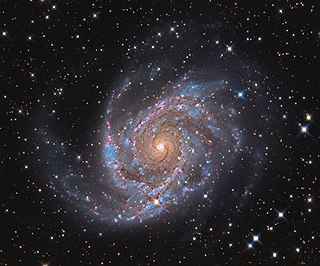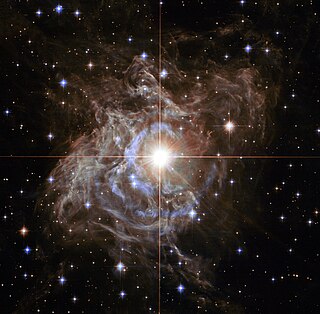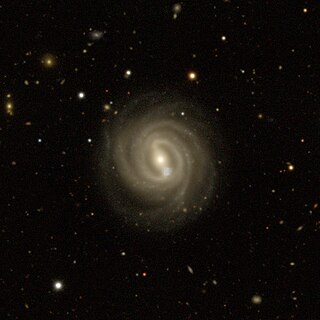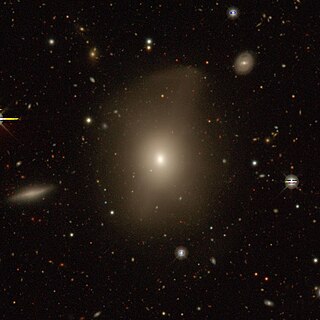
Sextans is a faint, minor constellation on the celestial equator which was introduced in 1687 by Polish astronomer Johannes Hevelius. Its name is Latin for the astronomical sextant, an instrument that Hevelius made frequent use of in his observations.

Messier 63 or M63, also known as NGC 5055 or the seldom-used Sunflower Galaxy, is a spiral galaxy in the northern constellation of Canes Venatici with approximately 400 billion stars. M63 was first discovered by the French astronomer Pierre Méchain, then later verified by his colleague Charles Messier on 14 June 1779. The galaxy became listed as object 63 in the Messier Catalogue. In the mid-19th century, Anglo-Irish astronomer Lord Rosse identified spiral structures within the galaxy, making this one of the first galaxies in which such structure was identified.

NGC 7793 is a flocculent spiral galaxy in the southern constellation of Sculptor. It was discovered in 1826 by Scottish astronomer James Dunlop. The galaxy is located at a distance of 12.2 million light years and is receding with a heliocentric radial velocity of 227 km/s. NGC 7793 is one of the five brightest galaxies within the Sculptor Group.

NGC 2997 is a face-on unbarred spiral galaxy about 40 million light-years away in the faint southern constellation of Antlia. It was discovered March 4, 1793 by German-born astronomer William Herschel. J. L. E. Dreyer described it as, "a remarkable object, very faint, very large, very gradually then very suddenly bright middle and 4 arcsec nucleus. This is the brightest galaxy of the NGC 2997 group of galaxies, and was featured on the cover of the first edition of Galactic Dynamics by James Binney and Scott Tremaine.

NGC 4639 is a barred spiral galaxy located in the equatorial constellation of Virgo. It was discovered by German-born astronomer William Herschel on April 12, 1784. John L. E. Dreyer described it as "pretty bright, small, extended, mottled but not resolved, 12th magnitude star 1 arcmin to southeast". This is a relatively nearby galaxy, lying approximately 72 million light-years away from the Milky Way. It is a companion to NGC 4654, and the two appear to have interacted roughly 500 million years ago. NGC 4639 is a member of the Virgo Cluster.

HM Cancri (also known as HM Cnc or RX J0806.3+1527) is a binary star system about 1,600 light-years (490 pc; 1.5×1016 km) away. It comprises two dense white dwarfs orbiting each other once every 5.4 minutes, at an estimated distance of only 80,000 kilometres (50,000 miles) apart (about 1/5 the distance between the Earth and the Moon). The two stars orbit each other at speeds in excess of 400 kilometres per second (890,000 mph). The stars are estimated to be about half as massive as the Sun. Like typical white dwarfs, they are extremely dense, being composed of degenerate matter, and so have radii on the order of the Earth's radius. Astronomers believe that the two stars will eventually merge, based on data from many X-ray satellites, such as Chandra X-Ray Observatory, XMM-Newton and the Swift Gamma-Ray Burst Mission. These data show that the orbital period of the two stars is steadily decreasing at a rate of 1.2 milliseconds per year as they thus are getting closer by approximately 60 centimetres (2.0 ft) per day. At this rate, they can be expected to merge in approximately 340,000 years. With a revolution period of 5.4 minutes, HM Cancri is the shortest orbital period binary white dwarf system currently known.

NGC 5962 is a spiral galaxy in the equatorial constellation of Serpens Caput. It was discovered by the Anglo-German astronomer William Herschel on March 21, 1784. The NGC 5962 galaxy is located at a distance of 120 million light years and is receding with a heliocentric radial velocity of 1,957 km/s. It is the brightest member of the eponymously-named NGC 5962 group, which overlaps with the nearby NGC 5970 group; the two groups may be gravitationally bound.

NGC 6340 is an unbarred spiral galaxy in the northern constellation of Draco. It was discovered by German-British astronomer William Herschel on June 6, 1788. The galaxy is located approximately 55 million light-years (17 Mpc) away, and is receding with a heliocentric radial velocity of 1,217 km/s. It is the largest member of a triplet of galaxies known as the NGC 6340 group.

RS Puppis is a Cepheid variable star around 6,000 ly away in the constellation of Puppis. It is one of the biggest and brightest known Cepheids in the Milky Way galaxy and has one of the longest periods for this class of star at 41.5 days.

NGC 4911 is a disturbed, warped spiral galaxy with a bright prominent central starburst ring and located deep within the Coma Cluster of galaxies, which lies some 300 million light years away in the northern constellation Coma Berenices. NGC 4911 is believed to be interacting with its warped, barred lenticular companion, producing the enhanced star formation and shell-like appearance seen in optical images. The galaxy contains rich lanes of dust and gas near its centre. The existence of clouds of hydrogen within the galaxy indicates ongoing star formation. It is rare for a spiral galaxy to be situated at the heart of a cluster.

Markarian 231 is a Type-1 Seyfert galaxy that was discovered in 1969 as part of a search of galaxies with strong ultraviolet radiation. It contains the nearest known quasar. Markarian 231 is located about 581 million light years away from Earth, in the constellation of Ursa Major.

NGC 3260 is an elliptical galaxy in the constellation Antlia. It is a member of the Antlia Cluster, which lies about 40.7 megaparsecs away. It was discovered on May 2, 1834 by the astronomer John Herschel.

Eta Piscis Austrini is binary star system in the southern constellation of Piscis Austrinus. As of 2000, the two components had an angular separation of 1.818 arc seconds along a position angle of 113.4°. The pair have a combined apparent visual magnitude of +5.43, which is bright enough to be seen with the naked eye. Based upon an annual parallax shift of 3.99 mas as seen from the Earth, the system is located roughly 820 light years from the Sun.
BD+43 3654 is a massive luminous blue supergiant runaway star in the constellation Cygnus.

NGC 5917 is a spiral galaxy located in the constellation of Libra. It was discovered by English astronomer John Herschel on 16 July 1835. This galaxy is located at a distance of 90.4 ± 6.2 million light-years (27.73 ± 1.90 Mpc) from the Milky Way, and is receding with a heliocentric radial velocity of 1,934.1 km/s. It is interacting with the neighboring galaxy, PGC 54817, at an angular separation of 4.2′. Tidal tails extend from PGC 54817 to the halo of NGC 5917.

NGC 3294 is a spiral galaxy in the constellation Leo Minor. It was discovered by William Herschel on Mar 17, 1787. It is a member of the Leo II Groups, a series of galaxies and galaxy clusters strung out from the right edge of the Virgo Supercluster. The galaxy is located at a distance of 98 million light years and is receding with a heliocentric radial velocity of 1,586 km/s. The morphological class of NGC 3294 is SA(rs)bc, which means this is a spiral galaxy with no central bar (SA), an incomplete inner ring structure (rs), and moderately wound spiral arms (bc).

NGC 824 is a barred spiral galaxy located in the constellation Fornax about 260 million light-years from the Milky Way. It was discovered by British astronomer John Herschel in 1837.

NGC 5966 is an elliptical galaxy in the constellation Boötes. NGC 5966 is its New General Catalogue designation. The galaxy was discovered by William Herschel on March 18, 1787. Based on its redshift, it is located about 220 million light-years away from the Sun.

NGC 1570, mistakenly called NGC 1571, is a faint galaxy located in the southern constellation Caelum, the chisel. It has a blue magnitude of 13.2, making it visible through a medium sized telescope. Based on a redshift of z = 0.014760, the object is estimated to be 198 million light years away from the Local Group. It appears to be receding with a heliocentric radial velocity of 4,392 km/s.


















